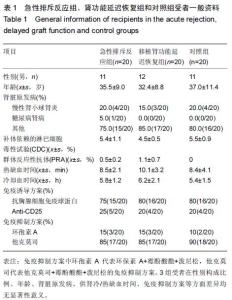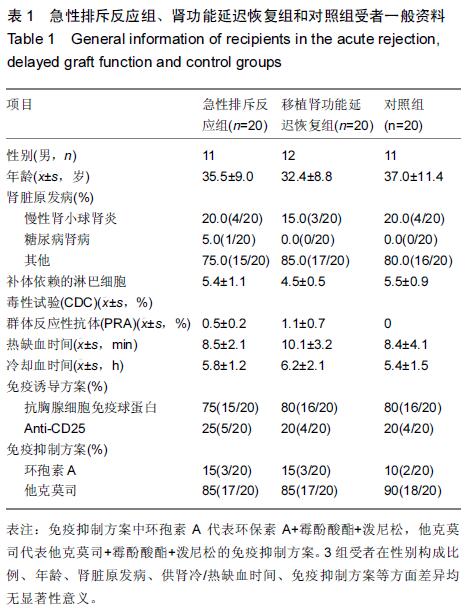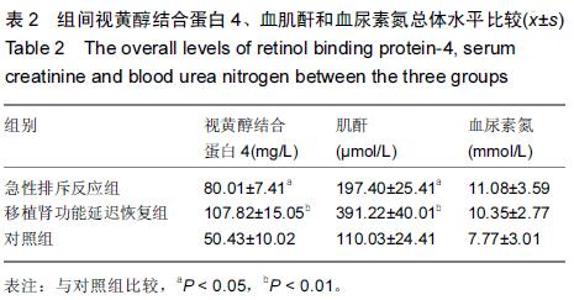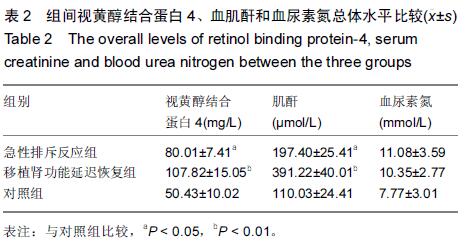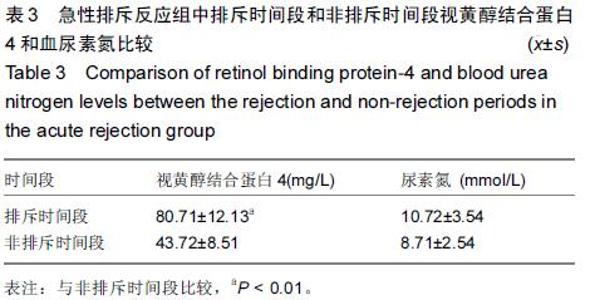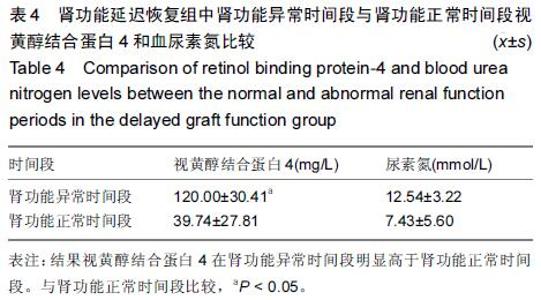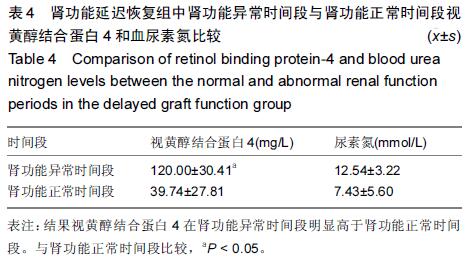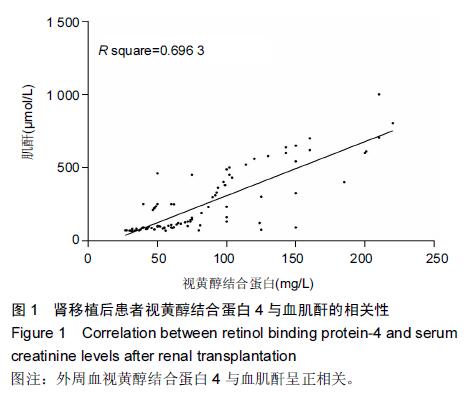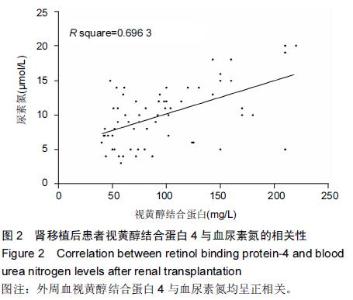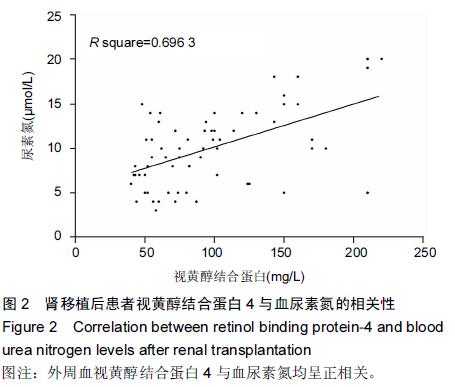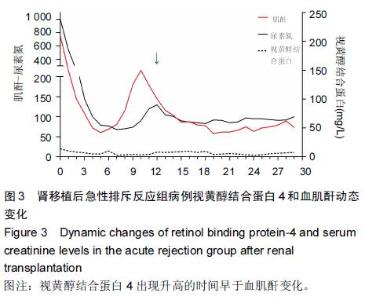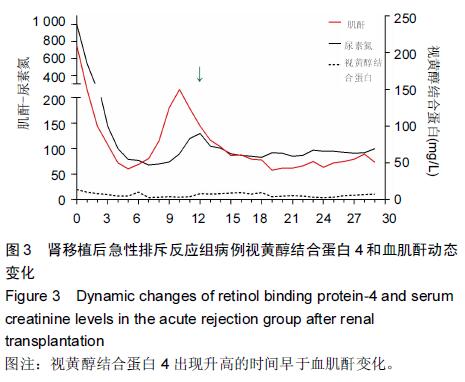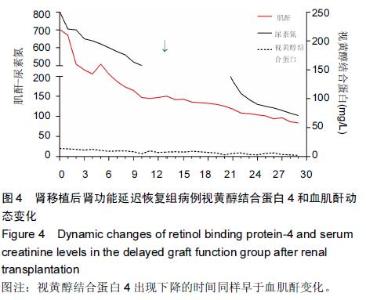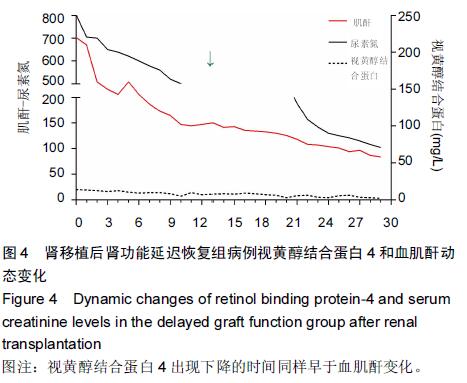Chinese Journal of Tissue Engineering Research ›› 2015, Vol. 19 ›› Issue (46): 7472-7477.doi: 10.3969/j.issn.2095-4344.2015.46.018
Previous Articles Next Articles
Continuous monitoring of peripheral blood retinol blinding protein-4 in the early stage after renal transplantation
Zhou Yu, Zheng Xue-yang, Lu Han-lan, Chen Yu, Fu Shang-xi, Wang Li-ming
- Organ Transplantation Institute of PLA, Changzheng Hospital, the Second Military Medical University, Shanghai 200003, China
-
Received:2015-09-06Online:2015-11-12Published:2015-11-12 -
Contact:Wang Li-ming, M.D., Professor, Chief physician, Doctoral supervisor, Organ Transplantation Institute of PLA, Changzheng Hospital, the Second Military Medical University, Shanghai 200003, China -
About author:Zhou Yu, Master, Physician, Organ Transplantation Institute of PLA, Changzheng Hospital, the Second Military Medical University, Shanghai 200003, China Zheng Xue-yang, Master, Attending physician, Organ Transplantation Institute of PLA, Changzheng Hospital, the Second Military Medical University, Shanghai 200003, China Zhou Yu and Zheng Xue-yang contributed equally to this work. -
Supported by:the Basic Research Program of Shanghai Science and Technology Committee, No. 11JC1416100
Cite this article
Zhou Yu, Zheng Xue-yang, Lu Han-lan, Chen Yu, Fu Shang-xi, Wang Li-ming. Continuous monitoring of peripheral blood retinol blinding protein-4 in the early stage after renal transplantation[J]. Chinese Journal of Tissue Engineering Research, 2015, 19(46): 7472-7477.
share this article
| [1] Tian YF, Liao CH, Chen MJ. Risk factors among donor characteristics which affect graft outcome in paired kidney transplantation. Transplant Proc.2008;40(7): 2281-2284. [2] Toma H, Tanabe K, Tokumoto T, et al. Time dependent risk factors influencing the long-term outcome in living renal allografts: donor age is a crucial risk factor for long-term graft survival more than 5 years after transplantation. Transplantation. 2001;72(5): 940-947.
[3] Jalalzadeh M, Mousavinasab N, Peyrovi S, et al. The impact of acute rejection in kidney transplantation on long-term allograft and patient outcome. Nephro urol Mon.2015;7(1): e24439.
[4] Fonseca I, Teixeira L, Malheiro J, et al. The effect of delayed graft function on graft and patient survival in kidney transplantation: an approach using competing events analysis. Transpl Int.2015 Feb.
[5] Norden AG, Lapsley M, Unwin RJ. Urine retinol-binding protein 4: a functional biomarker of the proximal renal tubule. Adv Clin Chem.2014;63: 85-122.
[6] 朱有华,石炳毅.肾脏移植手册[M].北京:人民卫生出版社, 2010: 520-530, 535-543.
[7] 陆瀚澜,张鑫,陈瑜.尿液中IP-10、Mig和OPG含量与移植肾排斥反应相关性的临床研究[J].中华器官移植杂志, 2012: 33(11): 672-675.
[8] Smith FR, Goodman DS. The effects of diseases of the liver, thyroid, and kidneys on the transport of vitamin A in human plasma. J Clin Invest.1971; 50: 2426-2436.
[9] Blaner WS. Retinol-binding protein: the serum transport protein for vitamin A. Endocr Rev.1989;10: 308-316.
[10] Naylor HM, Newcomer ME. The structure of human retinol-binding protein (RBP) with its carrier protein transthyretin reveals an interaction with the carboxy terminus of RBP. Biochemistry.1999;38: 2647-2653.
[11] Raila J, Willnow TE, Schweigert FJ. Megalin-mediated reuptake of retinol in the kidneys of mice is essential for vitamin A homeostasis. J Nutr.2005; 135: 2512-2516.
[12] Vahlquist A, Berne B, Berne C. Skin content and plasma transport of vitamin A and beta-carotene in chronic renal failure. Eur J Clin Invest.1982;12: 63-67.
[13] Blumberg A, Hanck A, Sander G. Vitamin nutrition in patients on continuous ambulatory peritoneal dialysis (CAPD). Clin Nephrol.1983;20: 244-250.
[14] Ziegelmeier M, Bachmann A, Seeger J, et al. Serum levels of adipokine retinol-binding protein-4 in relation to renal function. Diabetes Care.2007; 30: 2588-2592.
[15] Kelleher J, Humphrey CS, Homer D, et al. Vitamin A and its transport proteins in patients with chronic renal failure receiving maintenance haemodialysis and after renal transplantation. Clin Sci.1983;65: 619-626.
[16] Zhang WX, Zhou W, Zhang ZM, et al. Decreased retinol-binding protein 4 in the sera of patients with end-stage renal disease after kidney transplantation. Genet Mol Res. 2014;13(4): 8126-8134.
[17] [Gerlach TH, Zile MH. Upregulation of serum retinol in experimental acute renal failure. FASEB J.1990;4(8): 2511-2517.
[18] Yang Q, Graham TE, Mody N, et al. Serum retinol binding protein 4 contributes to insulin resistance in obesity and type 2 diabetes. Nature.2005;436: 356-362.
[19] Graham TE, Yang Q, Blüher M, et al. Retinol-binding protein 4 and insulin resistance in lean, obese, and diabetic subjects. N Engl J Med.2006;354: 2552-2563.
[20] Frey SK, Henze A, Nagl B, et al.Effect of renal replacement therapy on retinol-binding protein 4 isoforms.Clin Chim Acta. 2009;401: 46-50.
[21] Borek C, Smith JE, Soprano DR, et al. Regulation of retinol-binding protein metabolism by glucocorticoid hormones in cultured H4II EC3 liver cells. Endocrinology.1981; 109(2): 386-391.
|
| [1] | Wang Xiaobo, Wang Changan, Han Jianle, Yang Qingyan, Yang Shuaiping, Yang Junwei. Influence of conversion from cyclosporine to tacrolimus on glucose metabolism and cardiovascular risk profiles in stable kidney transplant patients [J]. Chinese Journal of Tissue Engineering Research, 2021, 25(14): 2236-2240. |
| [2] | Liu Junchang, Gao Xiaolin, Jiang Taimao. Correlation of CY3A5 genetic polymorphism with concentration/dosage of tacrolimus and individualized administration of tacrolimus after kidney transplantation [J]. Chinese Journal of Tissue Engineering Research, 2021, 25(11): 1740-1744. |
| [3] | Guo Juan, Zheng Shan, Xie Hui, Hu Yahui. An analysis of pathogenic bacteria infection in 422 kidney transplant recipients [J]. Chinese Journal of Tissue Engineering Research, 2020, 24(32): 5198-5202. |
| [4] | Liu Luhao, Fang Jiali, Zhang Lei, Li Guanghui, Xu Lu, Lai Xingqiang, Xiong Yunyi, Chen Rongxin, Ma Junjie, Chen Zheng. Clinical assessment criteria of donor pancreas transplants for simultaneous pancreas-kidney transplantation [J]. Chinese Journal of Tissue Engineering Research, 2020, 24(26): 4157-4161. |
| [5] | Liu Ting, Yang Tingting, Ma Xiaona, Ma Haibin, Jin Yiran, Liang Xueyun. Immunoregulation of allograft rejection: a role played by human CD200+ sub-population from human placenta-derived mesenchymal stem cells [J]. Chinese Journal of Tissue Engineering Research, 2020, 24(13): 2068-2073. |
| [6] | Yang Jin, Zhang Meixia, Yan Pei, Cheng Qiao, Li Jianzhen . Meta-analysis of risk factors for new-onset diabetes mellitus after kidney transplantation [J]. Chinese Journal of Tissue Engineering Research, 2019, 23(15): 2450-2460. |
| [7] | Yang Qi-shun1, Jiang Wei1, Huang Chi-bing2. Staging diagnosis and treatment for pulmonary infection after renal transplantation can improve the stability of transplanted renal functions [J]. Chinese Journal of Tissue Engineering Research, 2018, 22(8): 1255-1260. |
| [8] | Gong Yu-bo1, Liu Yong2, Zhao Hong-wei1, Xu Qian-qian1, Guo Hui-ling1 . Expression levels of Foxp3 and indoleamine 2,3-dioxygenase in mouse corneal allograft rejection [J]. Chinese Journal of Tissue Engineering Research, 2018, 22(28): 4513-4517. |
| [9] | Tian Ying, Wu Jie, Wang Shuang-yong. Polyethylene glycol: an expert of cellular camouflage confusing the immune system [J]. Chinese Journal of Tissue Engineering Research, 2018, 22(10): 1625-1633. |
| [10] | Shang Wen-jun, Wang Zhi-gang, Suo Jing-jun, Li Jin-feng, Pang Xin-lu, Feng Yong-hua, Liu Lei, Xie Hong-chang,Feng Gui-wen. Caspofungin for preventing fungal infection after kidney transplantation using donation after cardiac death donors: a prospective controlled trial [J]. Chinese Journal of Tissue Engineering Research, 2017, 21(32): 5189-5196. |
| [11] | Yang Jin, Fang Fang, Yang Fu. Risk factors for new-onset diabetes mellitus after kidney transplantation: a retrospective study [J]. Chinese Journal of Tissue Engineering Research, 2017, 21(20): 3275-3280. |
| [12] | Li Jin-feng, Sun Jia-jia, Feng Gui-wen, Shang Wen-jun, Pang Xin-lu, Liu Lei, Xie Hong-chang, Feng Yong-hua, Wang Zhi-gang. Effect of donor and recipient gender on the recovery of renal function after donation after cardiac death renal transplantation [J]. Chinese Journal of Tissue Engineering Research, 2017, 21(16): 2593-2599. |
| [13] | Lv Dao-yuan1, 2, Zhou Qin1, 2, Xia Yue1, 2, You Xu1, 2, 3, Zhao Zhi-hong4, Li Yong-qiang1, 2, Zou He-qun1, 2 . Establishment and analysis of a rat model of chronic renal allograft dysfunction complicated with insulin resistance [J]. Chinese Journal of Tissue Engineering Research, 2017, 21(12): 1894-1902. |
| [14] | Li Ling, Li Ning, Ai Zi-ye, Yao Ya-jun, Wei Wan-hui, He Wei-yang, Wang Yan-feng, Ye Qi-fa. Intra-patient variability of tacrolimus concentration in transplant recipients: a prognostic predictor post transplantation [J]. Chinese Journal of Tissue Engineering Research, 2016, 20(49): 7437-7422. |
| [15] | Chen Cheng, Gu Yu-wei, Zhang Jun, Hu Lin-kun, Wei Xue-dong, Hou Jian-quan. Mesenchymal stem cell transplantation for post-transplant renal function: a Meta-analysis [J]. Chinese Journal of Tissue Engineering Research, 2016, 20(36): 5432-5439. |
| Viewed | ||||||
|
Full text |
|
|||||
|
Abstract |
|
|||||
